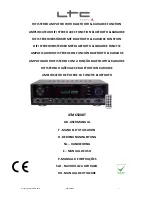
When the system described above is equalized in a typical cinema environment, both direct
sound and reverberant sound can be maintained quite smoothly, as shown in Figure 7A. The system’s
reverberant response is proportional to its power output, or to its power response, and the matching of
the system’s on-axis and power response indicate that the reflected sound field in the cinema will
have the same spectral characteristics as the direct sound from the loudspeaker. When this condition
exists, sound reproduction, especially dialog, will sound extremely natural. (The frequency response
contour shown in Figure
is the so-called “X-curve” recommended for cinema equalization, as
specified in
Document 2969.)
POWER
EQUALIZED
Figure 7. Cinema equalization of power flat systems
JBL pioneered the concept of flat power response in the cinema
It has become the
guiding principle in much of
product design, and it has been adopted by the industry at large.
G. Coverage Requirements for Proper Stereo Reproduction
In the cinema, it is expected that all patrons will be able to appreciate convincing stereo
reproduction. By contrast, standard two-channel stereo in the home environment often imposes strict
limitations on where the listener must sit in order to perceive correct stereo imaging. The factor that
makes the big difference in the cinema is the presence of the center channel. Not only does the
center loudspeaker lock dialog into the center of the screen, it further reduces the amount of common
mode information the left and right channels must carry, thus making it possible for listeners far from
the axis of symmetry to hear the three channels with no ambiguity or tendency for the signal to
“collapse” toward the nearer loudspeaker. In the Dolby stereo matrix, the same convincing effect is
largely maintained through gain coefficient manipulation during playback.
Ideally, each patron in the house should be within the nominal horizontal and vertical coverage
angles of
the high-frequency horns. This requirement can usually be met by using horns with a
nominal 90” horizontal dispersion and by toeing in the left and right screen loudspeakers. In very wide
houses, the spreading of high frequencies above approximately 5
as they pass through the
screen at high off-axis angles, actually helps in providing the desired coverage.
Another desirable condition is maintaining levels as uniformly as possible throughout the
house. We have found that aiming the screen systems, both high- and low-frequency, toward the back
wall helps in this regard, by offsetting normal inverse square losses with the on-axis “gain” of the












































